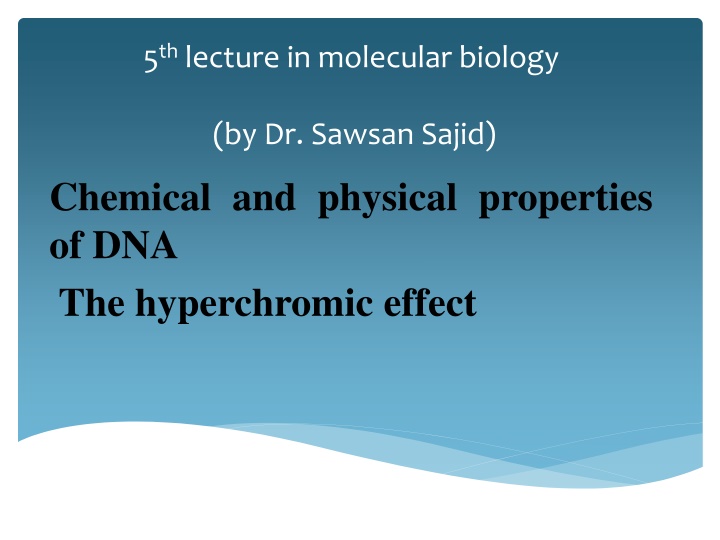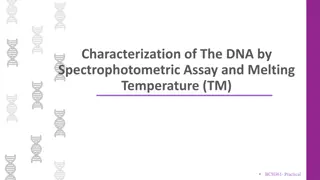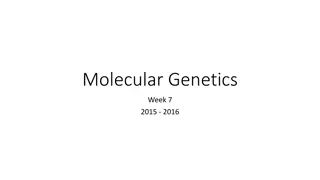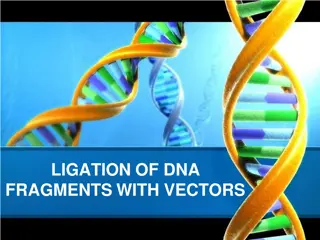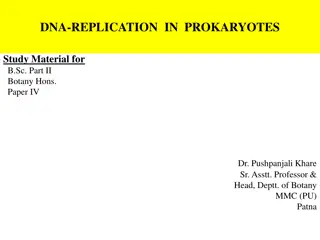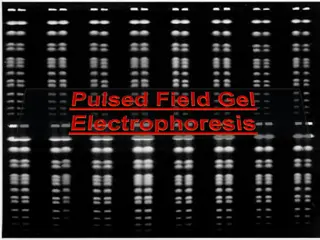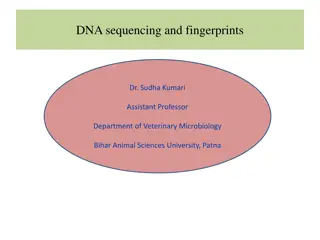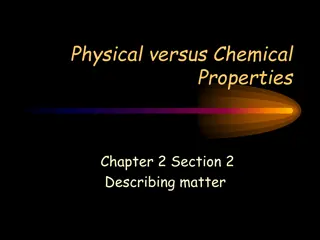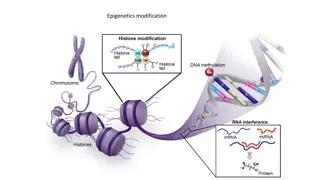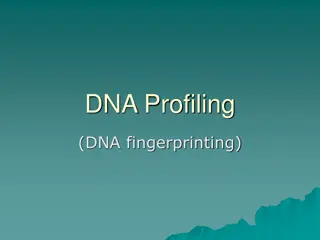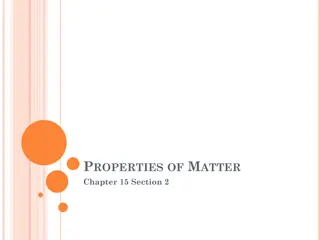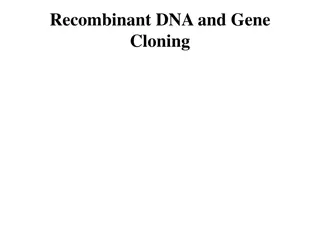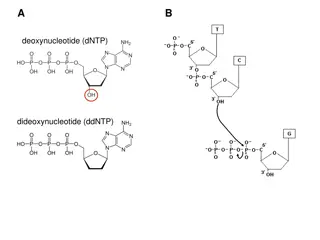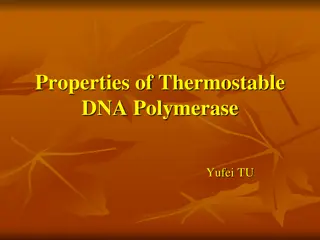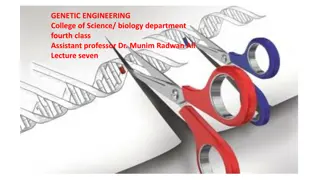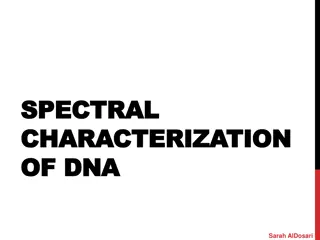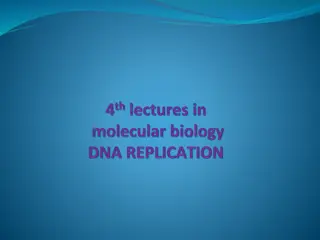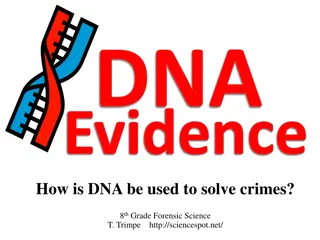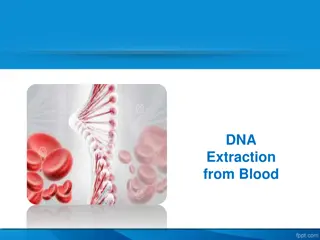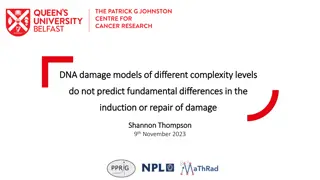The Chemical and Physical Properties of DNA
DNA's characteristics such as absorption of UV light, density measurement using cesium chloride, and size estimation through electrophoresis are key in molecular biology research. The hyperchromic effect, UV light absorption at 260nm, CsCl-density ultracentrifugation, and gel electrophoresis are crucial methods for studying DNA. These techniques help determine DNA concentration, purity, and size variations based on molecular density and charge interactions.
Uploaded on Oct 01, 2024 | 2 Views
Download Presentation

Please find below an Image/Link to download the presentation.
The content on the website is provided AS IS for your information and personal use only. It may not be sold, licensed, or shared on other websites without obtaining consent from the author.If you encounter any issues during the download, it is possible that the publisher has removed the file from their server.
You are allowed to download the files provided on this website for personal or commercial use, subject to the condition that they are used lawfully. All files are the property of their respective owners.
The content on the website is provided AS IS for your information and personal use only. It may not be sold, licensed, or shared on other websites without obtaining consent from the author.
E N D
Presentation Transcript
5thlecture in molecular biology (by Dr. Sawsan Sajid) Chemical and physical properties of DNA The hyperchromic effect
1-Absorption of UV light The bases in DNA absorb ultraviolet light at the wavelength of 260 nm using a spectrophotometer. Free nucleotide bases absorb more ultraviolet ligh 1-Free bases absorb 1.60 units at 260 nm 2-Single stranded DNA absorb 1.37 units at 260 nm 3-Double stranded DNA absorb 1.00 units at 260 nm
For that , DNA Concentration could be determined according to its ability to absorb ultraviolet light ( more DNA presents in specific preparation the higher absorption occurred). DNA most be fairly pure, since many contaminating substances (e.g., proteins) also absorb around this wavelength (protein absorbed uv at 280)
2-Density Density can be measured by (CESIUM CHLORIED ) CsCl-density ultracentrifugation . separate DNA based on density, DNA is mixed with CsCl and centrifuged at very high speeds (e.g., 50,000 rpm) in an ultracentrifuge for many hours. As the tubes spin, the opposing forces of sedimentation and diffusion produce a stable, linear gradient of CsCl with the lightest density at the top and the heaviest density at the bottom.
As the CsCl gradient forms, the DNA comes to equilibrium in the gradient where its density equals the density of the surrounding CsCl. If DNA of only one density is present, the result will be a single band of DNA. If two DNAs are present with different densities, the result will be two bands of DNA. GC base pairs are more dense than AT base pairs. Therefore, DNA with more GC base pairs will form bands lower down than an equal number of base pairs with high AT content
3- Size A -Electrophoresis DNA has a negative charge due to the negatively charged phosphates in the sugar-phosphate backbone. If DNA is placed in an electrical field it migrates towards the positive electrode (the cathode) If DNA is electrophoresed through a gel, smaller pieces will migrate faster than larger pieces Larger pieces have trouble squeezing gel matrix and are hence retarded while smaller pieces migrate easier The size of DNA is estimated by comparing its migration through the gel to DNA molecules of known size(DNA ladder) through the
Type of gels A-Agarose is a polymer of natural origin. It is derived from seaweed. it is used to separate fairly large DNA molecules up to 5 million to a few thousands base pairs B-Poly acrylamide is used to separate small pieces of DNA ( several hundred base pairs) DNA ladder
B: Electron microscopy The size of DNA molecules can be determined by electron microscope. The DNA is visualized on a grid of known size so that the size of the DNA molecule can be estimated C: Velocity sedimentation Sedimentation velocity is dependent upon two variables: density and shape The more dense the DNA the quicker it will sediment upon centrifugation Globular (more compact) molecules will sediment faster than linear molecules
4-Solublity RNA is more soluble in aqueous solutions than DNA . Ribose has a 2'-OH group which is polar and dissolve in water better where deoxyribose contains a 2'-H Hydroxyl groups C-H is a non-polar bond and is therefore hydrophobic RNA is less stable then DNA because The hydroxyl group on the 2' carbon of ribose is more reactive then hydrogen found in deoxyribose 5-Denturation Definition: DNA is considered denatured when the double stranded DNA molecule is converted into two single stranded molecules This can be monitored by observing the increase in absorption of ultraviolet light .Factors causes DNA Denaturation:
A-pH Acids pH lower than one (pH=1)result in the breakage of phosphodiester bonds between nucleotides and breakage of the N-glycosidic bond between the sugar and purine bases pH of around 4 results in the selective breakage of N-glycosidic bonds between the sugar and purines DNA treated this way is referred to a apurinic acid, since the purines have been removed. Alkali Base tends to change the polarity of groups involved in hydrogen bonds Above pH 11.3, all hydrogen bonds are disrupted and the DNA is totally denatured RNA is hydrolyzed into ribonucleotides around pH 11
B- Ionic strength low salt concentrations can lead to denature DNA strands. (DNA is a polyanionic molecule. High salt concentrations "shield" the negative charges on each phosphate. When the charges are NOT shielded in low salt concentrations, the electrostatic repulsion of the negatively charged strands makes it energetically more favorable to separate the strands.) Salts that dissociate into ions will neutralize the charges of the phosphate groups Salts will stabilize the DNA double helix resulting in a higher Tm
C-Temperature As thermal energy increases, the frequency of hydrogen bonds breaking between the molecules When the temperature increases, the two molecules will separate into single-stranded molecules The Tm (melting temperature) of a DNA molecule is the temperature in which half the DNA molecules are denatures The Tm is used to estimate the G+C content of a DNA molecule G-C base pairs are held together by three hydrogen bonds A-Ts by two and it therefore takes more energy (higher temperatures) G+C content of a DNA molecule can be estimated from its thermal melting temperature (Tm)
Heating double stranded nucleic acids causes the strands to unwind (denature) by disrupting the ordered stacking of the bases and breaking hydrogen bonds. The process can be conveniently monitored by an increase in UV absorbance as the double strands unwind to single strands (owing to hypochromicity). The thermal denaturation of double- stranded DNA is progressive and the concerted melting of the whole structure occurs at a well-defined temperature, corresponding to the mid-point of a smooth transition. This temperature is known as the melting temperature (Tm) .
Hyperchromic effect ( Nucleic acid thermodynamics): is the study of how temperature affects the nucleic acid structure of double stranded DNA (dsDNA). The melting temperature (Tm) is defined as the temperature at which half of the double DNA strands will convert to random coil or single-stranded (ssDNA) state. Tm depends on the length of the DNA molecule and its specific nucleotide sequence. DNA, when in a state where its two strands are dissociated (i.e., the dsDNA molecule exists as two independent strands), is referred to as having been denatured by the high temperature
Renaturation studies DNA that is denatured, often can come back together when condition are reversed . This is referred to as renaturation and it occurs because hydrogen bonds of complimentary base pairs reform Slowly lowering the temperature or adding ions to solution may lead to renaturation Renaturation rates are dependent on DNA concentration The more molecules of complimentary DNA molecules present, the faster they can find each other and renature DNA molecules in low concentration in solution will take awhile to find a complimentary partner, and will therefore renature slower
Hybridization( ) Hybridization is the process of annealing specific interaction between two complementary strands of nucleic acids into a single complex, which in the case of two a duplex. Oligonucleotides, DNA, or RNA will bind to their complement under normal conditions, so two perfectly complementary strands will bind to each other readily. Measuring the effects of base incompatibility by quantifying the temperature at which two strands anneal can provide information as to the similarity in base sequence between the two strands being annealed. The complexes may be dissociated by thermal denaturation, also referred to as melting. Here, the solution of complexes is heated to break the hydrogen bonds between nucleic bases, after which the two strands separate. Most commonly, the pairs of nucleic bases A=T and G C are formed, of which the latter is more stable strands is referred to as
NITROCELLULOSE FILTER HYBRIDIZATION northern blotting technique) (southern and Filter hybridization is a method used to determine the presence of homologous or complementary sequences in DNA or RNA, by allowing a denatured radio-labeled 'probe nucleic acid (in solution) to anneal denatured nucleic acid (immobilized to a nitrocellulose filter) to be tested. Using this specific filters containing the immobilized nucleic acid by a technique known as Southern blots, Northern blots. to the
The Southern Blot technique is useful for identifying a DNA sequence that appears only once or twice in the genome, DNA is applied to an agarose gel, and electrophoresis separates the fragments of DNA according to size. The gel is then placed on a thin sponge wick resting in a dish of salt solution, and a special filter (typically nitrocellulose) is placed on top of the gel. A stack of absorbent material (typically paper towels) is placed on top of this stack. The absorbent material draws the salt solution from the dish into the wick and through the gel by capillary action, which transfers the DNA fragments into the filter. The procedure is called a "Southern transfer" after the filter now contains the DNA fragments in the same pattern as the gel,
The filter is placed in a standard solution of radioactively-labelled DNA probe for a particular gene sequence. The probe binds to the filter only where a complementary DNA sequence is located. After washing to remove unbound probe, a piece of X-ray film is placed over the hybridized filter and left for several hours to several days. The radioactive label produces a black band on the film where it has stuck to the complementary DNA, producing an autoradiogram. If a labelled size marker has been used, the exact sizes of the fragments can be determine. The steps of southern and northern blotting is the same only DNA samples is replaced with RNA in the second procedure
Analysis of DNA by the Southern Blot technique(RNA by northern blotting technique)
